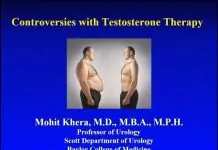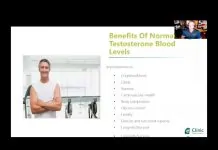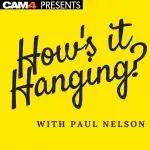Nelson Vergel, founder of ExcelMale.com and DiscountedLabs.com and author of Testosterone: A Man’s Guide, interviews Dr Ranjith Ramasamy. Dr Ramasamy is the Director of Male Reproductive Medicine and Surgery as well as an Assistant professor in Department of Urology at the University of Miami. As a Urologist and Microsurgeon, Dr. Ramasamy specializes in the treatment of disorders of male infertility and sexual dysfunction. His clinical research focuses on optimizing techniques for sperm retrieval and identifying factors for successful vasectomy reversal. His laboratory research focuses on using Leydig stem cells for treatment of low testosterone.
Dr. Ramasamy completed his Urology residency training at Weil Cornell Medical College and New York-Presbyterian Hospital. He then completed a National Institutes of Health sponsored fellowship in Male Reproductive medicine and Surgery at Baylor College of Medicine. In addition to his clinical accolades, Dr. Ramasamy has been integral to the advancement of male reproductive medicine and surgery. To date, he has published over 100 manuscripts in peer-reviewed journals and several book chapters.
TRANSCRIPT:
Nelson Vergel: Hello, everybody. This is Nelson Vergel founder of excelmale.com and discountedlabs.com. I am very happy to have Dr. Ramasamy with us today. He’s one of the top urologists and researchers in this country. I’ve known about him for a while, because he was here at Baylor in Houston, but what really caught my attention most of all was the review he published last year on The Role of Estradiol in Male Reproductive Function.
Estradiol’s role in men induces a lot of confusion, a lot of misconceptions. And we’re here, hopefully, to get some of your questions answered by Dr. Ramasamy, who has definitely reviewed most references out there.
Dr. Ramasamy is a director of Male Reproductive Medicine and Surgery, as well as assistant professor in the department of urology at the University of Miami. As urologist and micro surgeon Dr. Ramasamy specializes in treatment of its orders of Male infertility and sexual dysfunction. His clinical research focuses on optimizing techniques for sperm retrieval and identifying factors for successful vasectomy reversal. In some laboratory research focuses on using lactic cells and stem cells for the treatment of low testosterone, very interesting.
Dr. Ramasamy completed his urology residency training at Weill Cornell Medical College in New York Presbyterian Hospital. And then completed a National Institutes of Health and Sponsored Fellowship in Male Reproductive Medicine and Surgery at Baylor College here in Houston. In addition to his clinical ecolades Dr. Ramasamy has been integral to the advancement of Male Reproductive Medicine and Surgery. Today he has published more than a hundred manuscripts in peer reviewed journals and several book chapters. So, welcome, Dr. Ramasamy, thank you for joining us today.
Dr. Ramasamy: Thank you so much for having me, Nelson.
Nelson Vergel: Yeah, why don’t we start and review a little bit of the review … you published this in 2016 on the Asian journal of Andrology and it was very, very good review to reader, not too long, on the roles of estradiol. Why don’t we start with the first part here – role of estradiol in the brain.Dr. Ramasamy: So, I think one of the common misconceptions that people often have is that testosterone is often considered as the male hormone and estradiol, or estrogen, is more considered as a female hormone. So, people often think that for men testosterone is important and for women estrogen is important and they often forget that estrogen is very, very important in men. That’s we’re going to discuss during this interview today.
And at the same time testosterone is also very important in females and female sexual functions. So, the proper balance between testosterone and estradiol is, I think, critical. Especially in men for both – sexual health, as well as for reproductive function.
So, one of the questions that you asked was “What is the role of estrogen in the brain?” I think, unfortunately, the brain is a very complex organ and it has several areas which are very critical for the sexual function. And people have studied a showing that an estrogen receptors and androgen receptors in the brain are critically important in order to have proper libido. In fact, one of the common side effects of a drug called clomiphene citrate or Clomid, which we use often in men with reproductive abnormalities. Men often come to us complaining of impaired libido. That was one of the first instances wherein we thought estrogen is probably very important because, as everyone knows, clomiphene actually blocks the action of estrogen on the brain. And once you block the action of estrogen on the brain the estrogen receptors in the brain do not get activated and therefore these men complain of impaired libido. This is very interesting, because the estrogen levels in men who take Clomid are actually normal or even higher, but unfortunately, the action of estrogen on the brain is blocked. That’s what Clomid does. And so, therefore these men despite having normal levels of estrogen, not even high levels of estrogen, will not have proper libido effects that men who don’t take Clomid have.
So, I think that was one of the first instances where we found out that estrogen is important for libido, sex drive and sexual function and men, who were taking Clomiphene – Clomid, as they came and told us that “Doc, I don’t feel good.” This is not right. And when you look at their laboratory profile it will be perfect. The testosterone would have gone up, the estrogens would have gone up appropriately and we’ve got medications that we can adjust the estrogen, but they still feel shitty. And this is where we got the clue that estrogen is important, not just levels of estrogen in the blood, but action of estrogen on the brain is very critical for men to have proper libido and sexual function.
Nelson Vergel: So, Doctor, when we say estrogen vs. estradiol, what’s the difference? I mean – do we use those two terms interchangeably or …
Dr. Ramasamy: Yes, so there are three ways in which estrogen exists in the body. The most common way, and the most reliable way, measuring estrogen is the estradiol, which is the active component that acts on the receptors. So, when you’re ordering assays in a commercial laboratory most of the times they are checking estradiol. It’s 17 beta-estradiol, which is being checked, even though they tell you estrogen, because the other components do not exist in the blood with long enough half-life that can be measured. So, it’s the estradiol that gets measured and estrogen and estradiol should be used interchangeably although estrogens can comprise other smaller forms of estradiol, but the estradiol is what we refer to when we refer to estrogens.
Nelson Vergel: We have seen some data on the fact that the old assay, that used to use the electrochemiluminescence immunoassay (ECLIA) method, is not as reliable as the liquid chromatography, mass spectrometry (LC/MS) test. Can you tell us a little bit of the testing of estradiol in men and the use of the sensitive vs. the regular test that we used to use in the past?
Dr. Ramasamy: That’s very interesting, I mean – I think the bigger problem that we have with the different assays that are being used to test the reproductive hormones actually lies with testosterone. Because, unfortunately, testosterone is so variable, not just from assays to assay, but from time to time within the same day and from two different blood samples drawn from the same patient at the same time. Previously, immunoassay was being used a lot and that was the assay being used by most commercial laboratories, but I think practitioners have come to recognize that LC/MS or liquid chromatography mass spec is the most accurate way to measure these sex hormones, there has been a big push by the CDC actually and by the government to say that these hormones need to be standardized, so therefore most commercial laboratories now both Quest and LabCorp, as far as I know, are doing liquid chromatography mass spec and patients, whenever they get their blood drawn, should make sure that it’s the LCMS assay and if the RIA assay was being used to measure testosterone and estradiol they should request from another laboratory, that uses the LCMS assay.
Nelson Vergel: We, offered that LC/MS for both testosterone and estradiol on Discountedlabs.com. And why do you think estradiol is so vilified on forums as men mainly want estradiol to be zero? What do you tell these men?
Dr. Ramasamy: Estradiol has always been thought of as the female sex hormone, right? And high estrogen levels can have negative side effects, in fact the biggest problem with estrogen came from these hormone replacement trials, done back in 2002 and 2003 for women, postmenopausal women, where estrogen and progesterone were given in combination and there was an adverse event of increased cardiovascular side effects. And, so I think ever since that hormone replacement therapy for estrogen came about, I think estrogen has had a negative connotation in the lame public. And when we translate these findings now to men high levels of estrogen are bad. High level of estrogen can cause gynecomastia, it can cause excessive weight gain, it can cause excessive fluid retention, fluid retention can lead to hypertension. And is associated with blood clots, so elevated level of estrogen can form blood clots in the legs, in the lungs called DVT and pulmonary embolism, can cause atherosclerosis causing heart attacks and strokes.
After you hear all of the side effects estrogen sounds terrible. So, all men would absolutely want to have none of these things and would want it down to zero. But, unfortunately, estrogen also has very good effects. Estrogen is extremely important for bone health and men who have decreased or undetectable estrogen levels can have bone loss, leading to osteopenia and osteoporosis, that leads to increased fractures. So, I think estrogen has a negative connotation because of all of those side effects, but normal levels of estrogen are absolutely important. I think bringing estrogen down to zero and making it undetectable can lead to very harmful effects in men.
And so, when practitioner are deciding to manage estrogen they should be very careful and maintain it at normal levels, but not just bring it down to zero, just because they see a high level on an assay. Any time you see a high level on an assay the first thing you have to suspect is the assay and not the drug or the patient’s condition, repeat the blood test, from LCMS assay like you said. Make sure it’s accurate before you start giving a medicine and start treating it. Coz, once you start interfering with the physiology and start giving a medicine and start intervening you’ve lost the first base line level, that you started with. Once you give a drug, it’s going to change levels and you no longer have what the baseline estradiol level was. Yes, estrogen should be low, but should not be zero.
Nelson Vergel: Yeah, and that’s the question I was scared, what’s the optimum levels, but obviously that depends on the testosterone level, since 0.3% of testosterone aromatizes to estradiol, right? And, obviously somebody with 500 nanograms of testosterone will have different amount, than somebody with a 1000 nanograms on testosterone replacemen. That’s something that most guys in my world don’t seem to understand. Obviously there are some references that mention the ratio of the testosterone to estradiol, what’s the healthy ratio, not only for fertility, but also for libido. What the main complaints on my forum from those that took higher doses of anastrozole (Arimidex) that had doctors prescribing 1 miligram everyday or 1 miligram three times a week, which I think is crazy, and obviously they get to a estradiol level that is undetectable. They get, obviously, lots of libido, lots to sensitivity in the penis area, aching, and joint aches, … they can’t work out, they are all sore.
Patients are very freaked out about the possibility of getting gynecomastia. Especially, while you’re on testosterone replacement, like most of my viewers are. Gynecomastia is not all related to estradiol … Let’s talk a little bit of the fears of gynecomastia before we move on, because I think that drives that obsession of starting or overdosing anastrozole.
Dr. Ramasamy: This is interesting. So, men who were on testosterone therapy can have gynecomastia as a side effect, but in fact – most men with gynecomastia do not have an abnormal estrogen level. So, as soon a practitioner see gynecomastia and start seeing an estrogen level that’s within the normal limits they think the estrogen level needs to come down to zero. And so they use an anastrozole to bring that estrogen level down to zero and gynecomastia has not changed at all.
So, for men who have gynecomastia, who have normal estrogen levels are use of drug called tamoxifen. tamoxifen is selective estrogen receptor modulator, but unlike clomiphene it works more peripherally than centrally. So, clomiphene use blocks estrogen feedback on the brain and Tamoxifen blocks the estrogen feedback in the peripheral tissues. So, I use 20 miligrams twice a day for men who have gynecomastia, but have normal estradiol level.
Let’s get into the concept of normal estradiol level. What is normal and when we should treat and how should we treat this? So, Absolutely right – as the testosterone levels goes up estrogen levels go up. Some men have alter ratio that estrogen level are high with low testosterone level and that’s easy to treat. You start with blocking the conversion of testosterone to estrogen, to see if the testosterone would go up and the estrogen would go down.
But in men who are on testosterone therapy, who have ranges anywhere between 500 to 1000 nanograms I only start treating estradiol only if it’s above 60 picograms per ml. If it’s above 60 I use one miligram of Anastrozole once a week. Normally with that once a week dose the estrogen levels usually go down to normal, between … less than 50 is my acceptable of normal. If it’s above 80, so if the estradiol is above 80 picograms per ml, than I use 1 miligram twice a week or that’s the most I do. And doesn’t matter what it is, is it a 100, or whatever it is, usually 1 miligram twice a week will get people back to the normal range.
I think the use of 1 miligram once a day literature of using Arimidex (brand name for anastrozole) comes from the female breast cancer literature, wherein 1 miligram anastrozole once a day is used to prevent breast cancer occurrence. And so, obviously, this is a very important indication, but in trying to prevent all the estrogen from acting on any of the estrogen receptors for breast cancer. But in men I think using that same dose is totally inappropriate, because over there you’re trying to basically block all estrogen from acting. Over here you’re trying to bring estrogen down to normal levels, but you’re not trying to bring it down to zero. So, I think is very important to understand that anastrozole should be used carefully, like the doses that you mentioned – 1 miligram once a week, or 1 miligram twice a week, at the most. And the goal should never to bring it down to undetectable levels, but to bring it down to the normal range.
Gynecomastia is a side effect of testosterone therapy men should be aware of it. It can happen in the absence of elevated estrogen. If the estrogen is high, than that’s what I would go first. I would not start with tamoxifen. When the estrogen levels come back to normal than I would use Tamoxifen 20 miligrams twice a day and most men seem to do very well with it. Rarely they need to go and get surgery, but that’s very unusual.
Nelson Vergel: I’ve seen the same and what’s bothering me right now – I get to hear everything out in the field, obviously, because I have 15000 people posting ExcelMale.com . Some clinics are starting at baseline with anastrozole. They do not wait to see what estradiol will be at follow up without anastrozole. That bothers me, that’s happening more than you think and …Dr. Ramasamy: Unfortunately it’s the same trend, but testosterone, right?
[crosstalk 00:16:48] … with estrogen, but I mean – come on, we should talk about testosterone, whether clinics are giving out testosterone, testosterone injections or any testosterone replacement without checking the testosterone levels to see if it’s abnormal.Nelson Vergel: I’ve had some private conversations with doctors and they’re telling me: Nelson, the biggest thing I’ve been trying to avoid is getting e-mails and calls in the first two weeks of testosterone treatment when men think they are going to get gyno and their nipples are starting to itch, so it becomes almost like a management issue for me, so I describe it at baseline than at follow up, if the estradiol is too low I change the dose. I know a lot about gynecomastia, I’ve been reading all the references, there is actually good reference in teenagers, where the estradiol and testosterone where pretty much normal, in the normal ratio, but IGF-1 was elevated, so there’s a growth factor for mammary glands that has nothing to do with sex hormones. So I tell the guys there are many factors involved. Gynecomastia is rare. But let’s jump to the next question.
For example, when somebody has 80 picograms per milliliter of estradiol and their testosterone is 700 nanograms per deciliter, they may have abnormal liver metabolism or too much fat. Why do think that estradiol may be high in certain men with normal testosterone?
Dr. Ramasamy: Some people aromatize better than the others. And most of the aromatizing factors in the testis, testosterone gets produced from the testis. There are cells outside the germ cells, called Leydig cells, which have aromatase. Some men have more aromatase and they quickly switch testosterone into estrogen, some men have less aromatase and basically that’s what drives the difference. Being fat sometimes … I’ve never found this association to be true, people always say all fat people have more estrogen – not true. You see some very thin people with very high estradiol levels and some very fat people with very low estradiol levels. This whole concept of “oh, yes. You have more fat, so you’re gonna switch more of your testosterone to estradiol” doesn’t seem to occur in clinical practice.
It really depends on genetic variations and how good you aromatize vs. some people that don’t is what drives some men to have elevated estrogens and some don’t. We’ve all seen this – some guys with 1100 testosterone are on testosterone injections that estrogens come back at 30. And some guys at 500 nanograms and that estrogens are like 90. It all depends on how good or bad your aromatase enzyme works and it’s probably the underlying genetic differences that change between the two.
Nelson Vergel: I have another practical question that I haven’t been found a doctor to answer. We say that higher estrogen levels can cause water retention. But I asked doctors: Okay, when you give patient anastrozole do they lose water weight? Even on my forum, guys cannot tell me whether they lost water weight due to anastrozole.
Dr. Ramasamy: Testosterone itself can also cause water weight. That’s the conflicting issue here. Is it the estrogen that’s causing the water retention or it’s the testosterone causing it. Both of them are working around the same receptor. What’s what the challenge is, but I mean if the estrogen is high and they have the side effects of the high estrogen, if you give anastrozole it should work. The problem is most doctors would be scared of that may drop of the testosterone levels as well in addition to prescribing the Arimidex, so you don’t know which one caused what. Absolutely, if the testosterone level is in the normal range and the estrogen is high and they are complaining about water retention, and you have given the aromatase and now the estrogen drops most men will be happy. You will see that weight loss happen very quickly.
Nelson Vergel: Let’s jump into libido – sex drive. You published, I think it was a poster, that showed that people on forums were against … I posted that poster on my site and people were not happy when you concluded that guys with higher estradiol were having better libido. Was it a poster presentation at a conference?
Dr. Ramasamy: No, it was actually a publication in European Urology where we showed that men on testosterone therapy that actually have elevated levels of estrogen, actually reported a higher levels of libido, compared to men on lower estrogen levels. The concept being that in men who had normal testosterone levels, are on testosterone therapy, despite having lower estrogen levels, have lower libido. This was interesting because the idea for this study came from the New England Journal of Medicine paper by Finkelstein, where he gave young college grads, he gave them Lupron, which blocks LH and FSH, very hard study to do, I don’t know how people volunteered for this, gave us very good information. Because when he gave back testosterone, but at the same time blocked their estrogen, by giving them Arimidex – 1 miligram once a day, their sex drive did not come up, despite normal testosterone levels. They recovered normally that testosterone has kept going up, but the group that was given Arimidex, their sex drive do not improve. I extrapolated the idea to say this if this happens in young normal college kids, what happens in men who get testosterone therapy?. And we use basically that same concept, and looked at our patients on testosterone to see if men who were receiving Arimidex, or who have lower estradiol level would report differences in libido and that’s basically what we’ve found.
So, for men on testosterone therapy their estrogen levels should not just brought down just because they may go often to the abnormal range. You should use it carefully and basic on symptoms.
Nelson Vergel: So, estradiol really can be an enhancer of the functions of testosterone. Not only your sex drive, but also … our next subject is mood and brain function. There is a reason why nature put that hormone in our bodies, right, in male bodies.
Dr. Ramasamy: Absolutely.
Nelson Vergel: It is not a hormone that has its brakes on testosterone, but actually can enhance the effects of testosterone. Obviously, high levels of estradiol can decrease testosterone blood levels, because of the feedback loop. Let’s talk a little bit about the effect on mood. You have a section in your paper about serotonin receptors and estradiol. That’s also very interesting.
Dr. Ramasamy: Unfortunately, I think we’ve spoken about in the beginning of the interview – the brain is very complex organ, the limbic system, which drives sex drive and libido are still pretty unknown in terms of what hormones act and what receptors are important. Combination of serotonin and dopamine are obviously very important neurotransmitters for the libido and the sex drive. One of the studies, that basically showed that estrogen can work it’s action on serotonin receptors. Basically is very, very important that estradiol levels are normal for these serotonin receptors to be activated for libido. One of the important factors, that we’ve mentioned in the paper, was that for estrogen levels to be normal we will need to have serotonin receptors active and for these estrogen receptors to be active as well.
Dr. Ramasamy: Can we pause and re-record at another place, they are having a meeting over here?
Nelson Vergel: All right, we’re back. So, Dr. Ramasamy is back with us and we’re very excited because he has actually taken the time to review most papers on estradiol in men. So, let’s talk a little bit about this study that was very concerning. Very small study actually, like a case control study, in which men with erectile dysfunction were shown to have more venous leakage if they had higher estradiol blood levels. That’s what freaked out a few of my readers on excelmale.com. Can we talk about the pros and cons of that small study?
Dr. Ramasamy: It was a very small study in which they had basically looked at men with erectile dysfunction and they had well documented Penile Doppler results on. Obviously, for practitioners doing penile duplex is ultrasound study in which an injection of Trimix is given right before the ultrasound. Men get a full erection, it’s supposed to be a full erection and then doppler measurements are made on the blood flow, on the inflow and the outflow inside the penis. Just like any other ultrasound technology or ultrasound study is very subjective. Therefore, most practitioners don’t wait till men get a 100% erection, before doing the ultrasound. And if you do that, if you don’t wait for a full erection then your Venous Leak studies could be misinterpreted. Despite all of its subjectivity, it give us some information, that if the estrogen levels are too high then it can lead to possible Venous Leak and lead to erectile dysfunction. The one thing that was missing in this piece was is to see what were the testosterone levels. The testosterone levels are very important for erectile function and low testosterone in its own has been shown to be associated with mild erectile dysfunction. And there are now recent studies showing that, unless you’re having normal testosterone levels, even medications like Cialis and Viagra will not produce the desired effect.
So, is estradiol important in erectile function? Absolutely. But the important message there is testosterone is also important. To have the proper ratio between testosterone and estradiol is very, very critical. One of the important thing that I do in men who have erectile dysfunction, the first thing is I check the testosterone level. And if they have mild erectile dysfunction “Doc, I can get away with Cialis and Viagra.” Sometimes I don’t even start them on Cialis and Viagra and I just give them testosterone therapy and that usually does it. In this day and age where we live, we know that Cialis and Viagra are often not covered by insurance, whereas testosterone therapy for men with low testosterone and symptoms are often covered. And most men come back to me happy, saying “Doc, I don’t need to take Cialis and Viagra anymore. I don’t need to spend as much money to have good erections anymore. Just the testosterone therapy alone was able to fix that.” And I think that is very important message to convey, this is for men … specifically in mild erectile dysfunction. However, when you fast forward or move the spectrum a little bit in men who’ve had radical prostatectomy, men who have diabetes, men who have advanced erectile dysfunction giving them testosterone therapy and monitoring that testosterone is not very important.
Now we’re talking about non functional penile tissue, non functioning blood vessels inside the penis, because the diabetes and prostatectomy and nerves that there you need to do something to the penis. Whether you should treat with Viagra/Cialis or should think about intracavernous injections, or even a penile prosthesis.
For mild erectile dysfunction we can get away with Cialis and Viagra, or sometimes using testosterone without Cialis and Viagra. In men with advanced ED due to penile tissue issues then testosterone, estrogen – not very important.
Nelson Vergel: And I also find that most men do not know that some of the medications they are taking may be affecting their erectile function and libido and as we get older, you take more meds.
Dr. Ramasamy: Absolutely.
Nelson Vergel: Blood pressure medications, statins …
Dr. Ramasamy: Antidepressants.
Nelson Vergel: Even Tagamet which is antiacid. Many other things can. So, you know there’s always this war about the environment being against having a good erection, because there are so many factors involved there, not only psychological, but also biochemical and medication related.
Just before we jump, because I’m gonna forget, a lot of people are asking me about what’s coming up in the future. You’re doing some stem cell research with your folks with erectile dysfunction. Can you tell us about that work and where it’s heading? And how much more time before we see something in humans?
Dr. Ramasamy: Sure. So, hopefully – not long. One of the studies we’re doing, and we’re doing this in animals right now, but we actually plan to apply for a clinical trial very soon, is to use Leydig stem cells. So, men who are aging and have low testosterone have cells inside their testicles, called Leydig stem cells, so these are stem cells that have not differentiated and matured into an adult cells. We’re trying to see if we can get a biopsy at the testis and expand these cells outside. Expand the cells from hundred cells to a few million cells and grafted, meaning injected, under the skin. No man will want to have their testis injected, so we’re trying to see if this will work under the skin. The goal being – the testosterone will go up, but more importantly the FSH and LH, and the estrogen, and the hormonal axis will not be disrupted with these therapies. Because most of the testosterone therapies, as we all know, are a contraceptive, blocks the FSH and LH and your whole axis is disrupted. TRT can lead to lot of these side effects…hypertension, erythrocytosis, polycythemia and so on.
So, if we can somehow maintain this axis with natural FSH, LH, testosterone it goes up and the body knows when to shut the testosterone down. I think it’ll be fascinating. In this summer, I hope, we’ve applied for Provisional Patent, which is now gone through and we’ve been now submitting an IND to the DFA. It’s basically a clinical trial to be able to do this in humans. You asked where we are – 5-10 years away, but our clinical trial in humans will hopefully be a year or two away.
Nelson Vergel: So glad to hear. I saw data in mice? Is that what you use right now?
Dr. Ramasamy: Yes, right now we’re doing this with mice, but we’ve also taken human biopsies and grafted them in mice and we’ve shown that works. Now we’ve got to do it from human to human and the reason we’re doing it in the same person is so we never have this problem of immunology, when there’s different antibodies that could work against these stem cells.Nelson Vergel: We’re excited, I mean – will definitely have another webinar when you have more details to share. How about estradiol’s role in sperm quantity or quality in men.
Dr. Ramasamy: Both testosterone and estradiol are extremely critical, I think when people are being blocked with estrogen and never … have very, very low levels of estrogen the sperm, not just the concentration, but the motility and the quality has been shown to be very poor. In fact, in men who have very high levels of estrogen, their sperm concentration and quality is also very low. It has to be optimal, you cannot bring it down to zero and you cannot have it more than 80 or 90 picograms per ml. It’s got to be somewhere in this normal range and the ideal, I think we touched upon this a little bit, the ideal testosterone to estradiol ratio is 10:1. You want the testosterone to be 10 times higher than estradiol (using same units when dividing the two). In men with infertility the ratio is altered, so it’s usually 5:1. The estrogen levels are high and we usually give anastrozole in men with infertility to improve their sperm count test since their estrogen is high and their testosterone to estradiol ratio is low. Estrogen is very important for sperm, you shouldn’t have it too high and it should not be undetectable either. Nelson Vergel: Do you only use anastrozole, clomiphene and tamoxifen, or do you use any other estrogen blockers?
Dr. Ramasamy: The only other estrogen blocker that’s been used, but no longer used is … it used to be an old drug called testolactone, which has come off the market. Some practitioners use letrozole and it lasts a little bit longer, I haven’t seen much differences between anastrozole and letrozole. I’m very happy using anastrozole, but letrozole is also used, those are the only estrogen blockers that are available.
Nelson Vergel: Some guys are using Aromasin (exemestane)
Dr. Ramasamy: No, I don’t prescribe it.
Nelson Vergel: Some swear they like it better.
Last, but not least, let’s cover two things: the bone mineral issue and estradiol and any issues related to lipids and cardiovascular health. Any effect of high/low estradiol or too much anastrozole on heart disease?
Dr. Ramasamy: High levels of estrogen have been associated with atherosclerosis, one of the reasons why are the hormone replacement and post menopause in women became such a hot topic, because it was associated with increased risk of heart attacks and strokes, thought to be leading either elevated thrombosis from platelet dysfunction or from atherosclerosis, because of lipid dysfunction. I think normal levels of estrogen, at least for a that reason should be maintained and to maintain proper lipid physiology.
As far as bone health is concerned I think it’s extremely important.. men often think they are going to fall and die of fractures when they become 90 years old. I think this is not true if you go on anastrozole for three months, just three months – 1 miligram, once a day. People have shown that you’ve already have bone loss on DEXA scan. It’s extremely important men with low testosterone have had increased risk of osteoporosis and fractures, because you don’t have enough testosterone, you don’t make enough estrogen and you lead to bone fractures. I think it’s very important that men and practitioners to understand that bringing estrogen down to undetectable levels, keeping them at undetectable levels long-term, can lead to irreversible bone loss, because once the bone that bone is lost you’re not getting it back. You could supplement with estrogen, turn off the anastrozole, but we should all be aware, or scared of, are these irreversible side effects that we cannot gain and bone loss is, certainly, one of them.
Nelson Vergel: I quess… it’s almost an hour. I will be posting this video on youtube, I’m gonna be getting it transcribed, so people can read the content too. And, promise me, that this is not gonna be the last one. We can do another topic like the use of HCG since that’s another hot topic. So, maybe next time we can talk about HCG and sexual function and fertility.
Dr. Ramasamy: Yeah, absolutely. Listen, thank you very much for having me and I think the message that needs to get conveyed is that, and this is probably true for everything in life, right? Too high is not good, and too low is not good either, right? Everything in moderation is probably perfect and I think that’s the message that needs to be conveyed, but estrogen too high not good, too low is not good either. And just taking an anastrozole from the get-go, without checking estrogen levels and not worrying about the side effects, is not a good thing either. So, thanks for having me and I hope we’ve conveyed that message through.
Nelson Vergel: Thank you so much and will see you soon, okay?
Dr. Ramasamy: Okay. Bye, bye.
Nelson Vergel: Bye, bye.
To make an appointment with Dr Ramasamy, visit his site: https://www.ranjithramasamy.com/
Recent Posts
How Long Does TRT Take to Show Effects?
A review of studies attempted to determine the time-course of the effects induced by testosterone replacement therapy from their first manifestation until maximum effects...
Fatigue- When Testosterone Is Not Enough
Taken from the book: Testosterone: A Man’s Guide by Nelson Vergel
If no improvements in fatigue are observed after 6 weeks of testosterone replacement, factors...
Where to find syringes, ED drugs, doctors, HCG, and much more
Syringes
https://www.otcwholesale.com/diabetic-syringes.html
https://www.medical-and-lab-supplies....-syringes.html
www.gpzservices.com
ED drugs no prescription
https://mysecuretabs.net/viagra100mg.html?id=501
Compounding Pharmacies:
www.empowerrxpharmacy.com
www.apsmeds.com
Affordable lab tests anywhere in the US without a prescription:
www.DiscountedLabs.com
How to Find a Doctor:
https://www.excelmale.com/showthread....nd-Anastrozole
Free ebook:
https://excelmale.com/Ebook-Optimize-...stosterone.pdf
Supplement info:
www.examine.com
HCG info:
https://www.excelmale.com/showthread....erve-Fertility
HCG Prescription Program
https://excelmale.com/HCG/
Simple Testosterone...
Anabolic Steroid Side Effects- Part 1
Anabolic Steroid Side Effects- Part 1
By Mauro DiPasquale, M.D.
As used by most athletes, the side effects of anabolic steroid use appear to be minimal....
Interview with Dr. Michael Scally About Optimizing Testosterone Therapy- Part 1
Interview with Dr. Michael Scally About Optimizing Testosterone Therapy- Part 1
Nelson Vergel (NV): Dr. Michael Scally is a well-known expert on men’s health in...
















